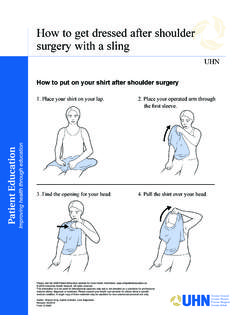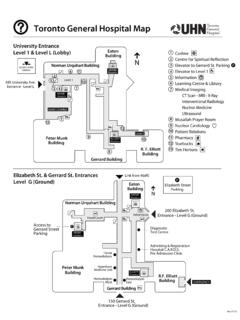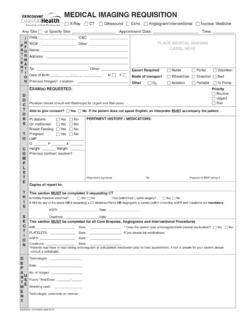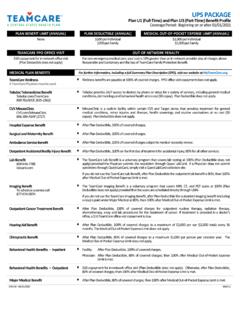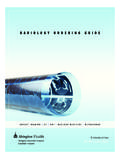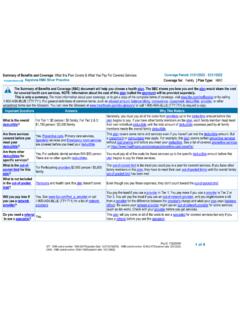Transcription of What You Need to Know About Your Nephrostomy Tube
1 What You Need to Know About Your Nephrostomy TubeRead this information to learn About : what a Nephrostomy tube is and why you may need one how to prepare for the procedure what you can expect how to care for your Nephrostomy tube who to call if you have any questionsLet's work together to keep your Nephrostomy tube working well and free from infection. What is a Nephrostomy tube?A Nephrostomy tube is a catheter (a thin tube). It is put in through your skin and into your kidney to drain your urine (pee). Why would I need a Nephrostomy tube?You may need a Nephrostomy tube when something is blocking your normal flow of urine. Urine from your kidney passes through tubes called ureters. Your ureters are connected to your bladder. If they get blocked, the urine will stay in your kidney and cause damage to it.
2 A Nephrostomy tube is put in to drain the urine directly from your may need this tube if you have kidney stones, pelvic tumours, damage to your urinary system or prostate for patients and familiesPlease visit the UHN Patient Education website for more health information: 2017 University Health Network. All rights reserved. This information is to be used for informational purposes only and is not intended as a substitute for professional medical advice, diagnosis or treatment. Please consult your health care provider for advice About a specific medical condition. A single copy of these materials may be reprinted for non-commercial personal use : Pauline Lambert, medical imaging ; revised by Karen MacDonaldReviewed: 09/2017 Form: D-53492 How do I prepare to have a Nephrostomy tube put in?
3 Before the procedure: ;Get your blood tests done 7 days before your procedure date. The doctor who scheduled you for the procedure will give you a requisition (an order form) for these blood tests. ;Some medicines may increase your risk of bleeding during or after your procedure. Tell your doctor or health care provider if you are taking: medicines such as acetylsalicylic acid (Aspirin), clopidogrel (Plavix), prasugrel (Effient), ticagrelor (Brillinta), ibuprofen (Advil, Motrin, Nuprin), naproxen (Naprosyn) or indomethacin medicines such as warfarin (Coumadin), dalteparin (Fragmin), enoxaparin (Lovenox), tinzaparin (Innohep), fondaparinux (Arixtra), dabigatran (Pradaxa), rivaroxaban (Xarelto) or apixaban (Eliquis)Your doctor or health care provider may tell you to stop taking these medicines for a certain number of days before your procedure.
4 ;Plan for someone to take you home after your procedure and stay with you overnight. You can t go home by yourself. If you don t get these blood tests done, the hospital may have to cancel your day of your procedure:Don t eat or drink anything after midnight (12:00 am) before your procedure. If you need to take medicine, take it with only a sip of water. ;Bring your Ontario health card (OHIP). ;Check in at the medical imaging Reception Desk 1 hour before your appointment. We use this time to get you ready for your you check in, we: bring you to the medical imaging Day Unit help you change into a hospital gown ask you questions About your health and medicine history give you an intravenous (IV) so that you can have pain medicine and sedatives (medicine to relax you) during your procedure answer any questions you have ask you to sign a consent form.
5 Signing this form means you agree to have the can I expect?1. We bring you into the procedure room and place you on your stomach or side. We connect you to a monitor that shows your blood pressure, heart rate and oxygen The nurses give you oxygen and medicine to help you relax. 3. We clean the area of your body where we place the The doctor uses a needle to give you a local anesthetic (numbing medicine) in the area of your body the tube goes in. 5. Once your skin is numb, your doctor uses a needle and wires, an ultrasound and an x-ray machine to guide the tube into the right place in your We connect the tube to a bag to collect the urine and keep the tube in place with dressing. We also secure the bag to your leg to make sure the tube stays in We then move you onto a stretcher and take you to the medical imaging Day Unit for About 4 After About 4 hours, you can go home.
6 You must have someone take you home from the hospital and stay with you patients stay in the hospital overnight. Your doctor would let you know and arrange this during an appointment before your Care Access Centre (CCAC) will contact you to plan for a nurse to help care for your tube. It s normal to feel sore for About 1 week after this procedure. You can take Tylenol for any can I do when I get home?For 24 hours after you get home: Don t drive a car or use heavy machines. Don t drink alcohol. Don t make any financial or legal for the rest of the do I care for my Nephrostomy tube?Your Nephrostomy tube is in a place that makes it hard for you to take care of it by yourself. You will need help. We can train a family member to help you or work with your local CCAC to have a community nurse help you.
7 Your Nephrostomy tube is not stitched in place. It is attached to your skin with 2 pieces of clear dressing. We give you a brochure called How to Change Your Drainage Tube Dressing to show you how to change your Nephrostomy tube dressing. If the clear dressing comes loose, tape it down until a nurse can change the whole dressing. Don t remove this clear dressing. Your tube could fall important points to remember: Keep the bag that is connected to your tube securely in place. To protect your tube, pin the bag to your clothes using safety pins. Or, use the leg straps to keep it in place. There should be no pulling or stretching on the tube connected to the bag. Check the tube to make sure it is in place after you shower, change your clothes or do other activities.
8 Make sure you empty the bag often. This will prevent pulling on the tube and help keep it in place. Keep the skin around your tube dry. When you shower, if your tube area gets wet, dry the skin completely. Clean the skin around the tube every day using soap and water. You can cover the tube with sterile (clean) gauze if you like. Make an appointment to have your tube changed every 3 or 4 months or when problems problems should I look out for?This chart lists problems you may have, how to prevent them and what to do if they to prevent itWhat to do if it happensThe skin around your Nephrostomy tube is :Your skin is red, sore and/or your tube and the skin around your entry site (where the tube goes in) once or twice a day.
9 Change your dressing 2 times every day. Clean your tube and skin with normal saline (you can buy it at your pharmacy). Put antibiotic ointment (like Polysporin) around the entry site every time you change your dressing. Then, put dry, sterile gauze over the this for 1 week. If your skin doesn't get better after 5 days, talk to the doctor who ordered this tube for have a kidney infection. Your Nephrostomy tube may not be draining : You feel pain in your kidney area (middle of your back). You have fever and chills. There are changes in how your urine looks and smells. Rinse your drainage bag with clean water every day. Change your Nephrostomy tube every 3 months. Keep the tube taped to your skin and keep the drainage bag below the level of your kidneys.
10 Drink lots of fluids each day unless your doctor gave you different instructions. If your tube is capped, uncap it and connect your tube to a drainage bag. Call your doctor right tube will probably be changed within 48 hours. You may need to start taking to prevent itWhat to do if it happensYour tube has partly or completely fallen : Your tube looks like it has moved or is completely out. No urine is draining into the bag. There is leaking at the entry site of your tube. Make sure your bag is firmly in place. Use safety pins or leg straps. Don't pull off the clear dressing without help. Check your dressing every day to make sure it is securely in place. Call your doctor or the Clinical Nurse Coordinator to make an appointment that same day.





